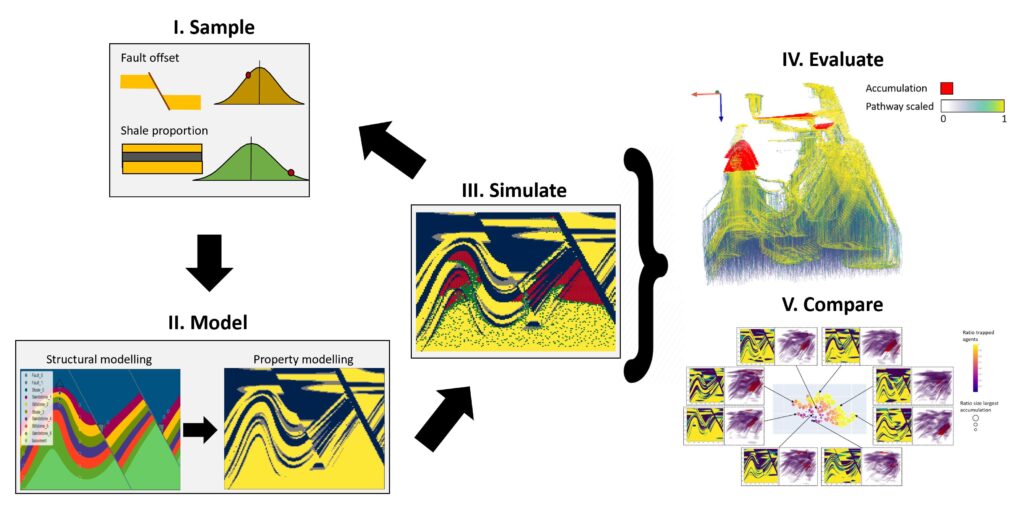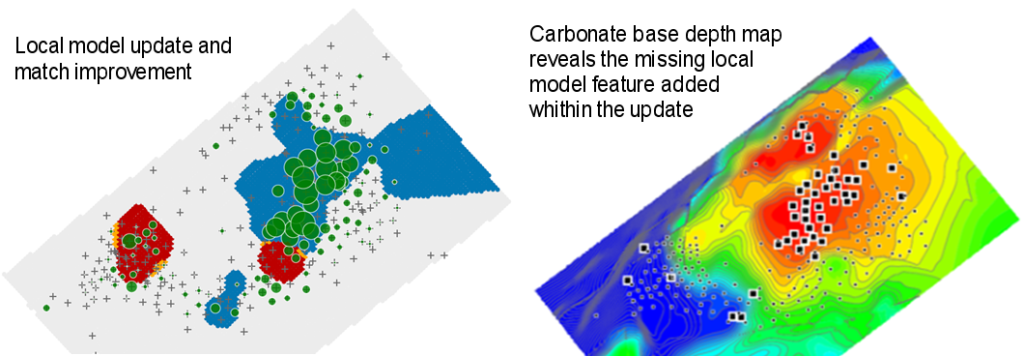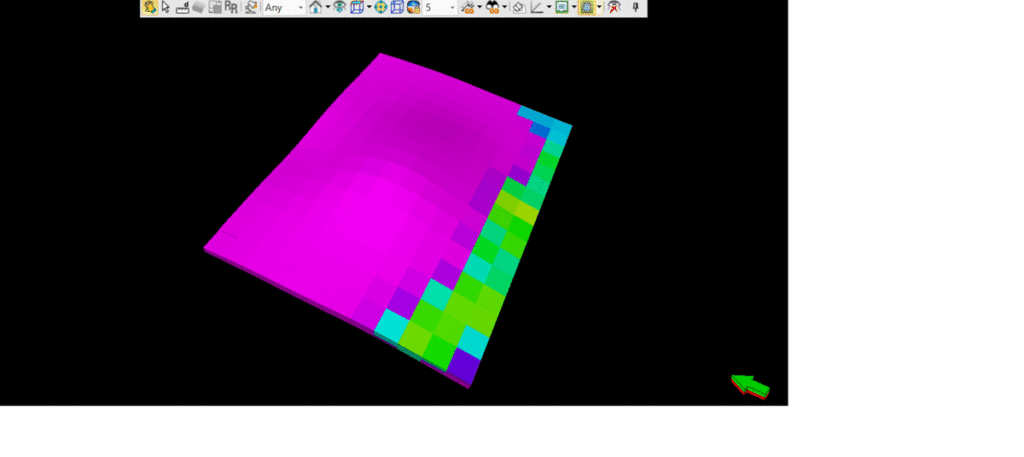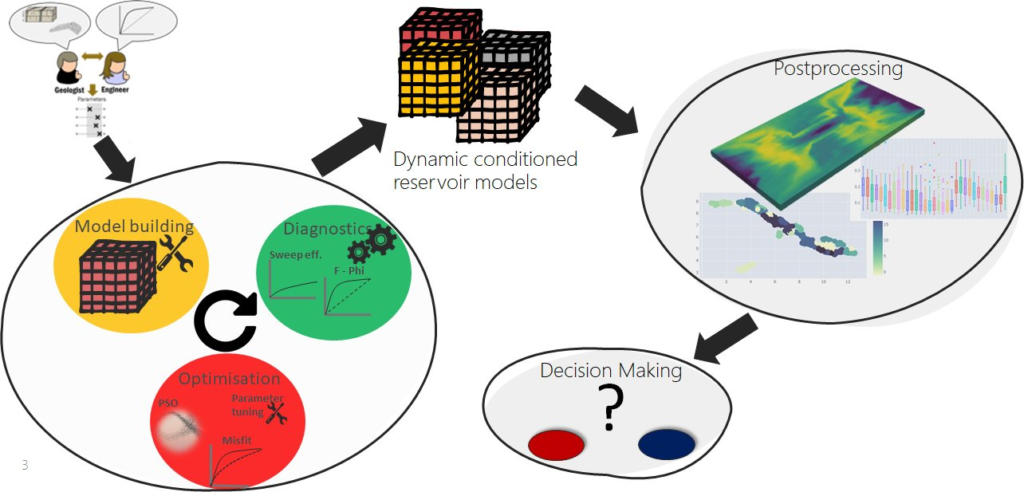outcomes of subsurface resources development
under uncertainty
Forecasting dynamics of complex subsurface systems is hard because of a tremendous amount of the associated uncertainty, which is difficult to capture and infer in modelling workflows. Prediction modelling of complex subsurface system dynamics under uncertainty usually involves solving an inverse problem to infer uncertain reservoir properties. We follow various approaches to propagate and infer subsurface uncertainty to predict subsurface system performance that involve physics-based proxies, dynamic data integration and model update, predictive reservoir analytics and machine learning.
- Agent based hydrocarbon migration modelling
- Geologically realistic dynamic model update
- Geomodel update via latent space with VAE
- Uncertainty modelling workflow to calibrate fracture reservoir model based on physics based proxy
- Reservoir model update for uncertainty prediction based on patterns discovered in dynamic response
Agent based hydrocarbon migration modelling
Published at Energies, MPDI open access: Can Agents Model Hydrocarbon Migration for Petroleum System Analysis? A Fast Screening Tool to De-Risk Hydrocarbon Prospects
Understanding and modelling hydrocarbon migration in the subsurface is a crucial task for in subsurface resources evaluation. A major factor influencing the migration pathway of hydrocarbons are the surrounding lithologies as well as structural features such as faults and fractures. Despite being very powerful, simulating hydrocarbon migration with conventional petroleum system modelling software can be very time consuming (up to days) and make it infeasible for extensive exploration of uncertainty. To overcome this problem, our group developed an algorithm for agent-based hydrocarbon migration that runs within a fraction of conventional software and can be utilized as a screening tool to explore uncertainties for different plays and scenarios prior to applying conventional petroleum system modelling software.


A fast-screening tool to de-risk hydrocarbon prospects“ by Bastian Steffens, Quentin Corlay, Nathan Suurmeyer, Jessica Noglows, Dan Arnold and Vasily Demyanov, in MDPI Open Access Energies special issue on “Machine Learning in Reservoir modelling workflows”
This work came an outcome of the the 1st prize award by Bastian Steffens and Quentin Corlay in the international online programming data/geoscience competition “Go with the flow” organised by Xeek and supported by Shell.
Geologically realistic dynamic model update
A novel data driven workflow aims to improve local history match quality by identifying model regions from correlation between production response and geological modelling parameters. The workflow is implemented in an assisted history matching framework for a large mature field case study an 8.8% improvement in oil rate misfit. The local update regions are identified by calculating the partial correlation between individual well production misfits and uncertain geological modelling parameters. This case study demonstrates the effective identification and utilisation of geologically and dynamically inferred regions which improve the local history match

from Production Response and Geological Parameter Correlations” by T. Buckle, R. Hutton, V. Demyanov, D. Arnold, A. Antropov, E. Kharyba, M. Pilipenko and L. Stulov, presented at EAGE Petroleum Geostatistics 2019
Geomodel update via latent space with VAE
Model update is challenging in presence of interpretational uncertainty, when possible geomodel scenarios dare represented by different concepts, set of model equations and combinations of model parameters. Subsurface model update is implemented via a latent space described by Variational Auto-Encoders (VAE). Latent space describes the variation of reservoir model properties across multiple scenarios. Navigation across the latent space from scnario A1 to scenario A2 (single sand body) via scenario B (two sand bodies) demonstrates how the model update transitions through different states.


Uncertainty modelling workflow to calibrate fracture reservoir model based on a physics based proxy
An automated reservoir modelling workflow is developed for fast uncertainty prediction of fracture reservoir dynamics based on multiple models. The workflow combines an iterative optimisation algorithm (PSO) that links up an with flow diagnostics, a fast proxy for fluid flow simulations based on the time of flight flow diagnostics. The goal here is to not only generate an ensemble of reservoir models in a fast manner, but also to carry a sufficient degree of geological realism throughout the entire modelling workflow.

Reservoir model update for uncertainty prediction based on patterns discovered in dynamic response
The uncertainty workflow aims to find an ensemble of geologically consistent scenarios that would honor production history. The uncertainty represented by a prior range of model scenarios may not be resolved by HM due to missing local features in the reservoir model description. We use data analytics can improve efficiency of ensemble history matching by analyzing links between the static and dynamic model ensemble update: screening of the initial ensemble, model localization based on spatial analysis dynamic observations to the parameter update and identification of conflicts between groups of production observations that prevent balanced model update.

E. Tolstukhin, E. Barrela, A. Khrulenko, J. Halotel and V. Demyanov, presented at EAGE Petroleum Geostatistics 2019,
